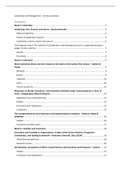Leadership and Management – articles summary
Contents
Week 1: leadership ................................................................................................................................. 4
Leadership: Past, Present, and Future – Day & Antonakis .................................................................... 4
What is leadership ............................................................................................................................... 4
History of leadership research ............................................................................................................ 4
Leadership: science, nature and nurture ............................................................................................ 6
The Forgotten Ones? The Validity of Consideration and Initiating Structure in Leadership Research -
Judge, Piccolo, and Ilies ........................................................................................................................... 7
Results ................................................................................................................................................. 7
Discussion ............................................................................................................................................ 8
Week 2: motivation ................................................................................................................................ 9
Work motivation theory and the research at the dawn of the twenty-first century – Latham &
Pinder ...................................................................................................................................................... 9
Behavior............................................................................................................................................... 9
Needs ................................................................................................................................................... 9
Cognitive ............................................................................................................................................ 10
Extra................................................................................................................................................... 10
Person-context fit .............................................................................................................................. 10
Motivation in Words: Promotion- and Prevention-Oriented Leader Communication in Times of
Crisis – Knippenberg, Wisse & Pieterse ............................................................................................... 12
Regulatory focus and leadership ....................................................................................................... 12
Studies ............................................................................................................................................... 14
Discussion and implications .............................................................................................................. 15
Limitations ......................................................................................................................................... 15
The Interplay Between Goal Intentions and Implementation Intentions – Sheeran, Webb &
Gollwitzer .............................................................................................................................................. 16
Studies ............................................................................................................................................... 16
Conclusion and discussion ................................................................................................................. 17
Week 3: creativity and innovation ....................................................................................................... 18
Innovation and Creativity in Organizations: A State-of-the-Science Review, Prospective
Commentary, and Guiding Framework – Anderson, Potocnik, Zhou (2014) ...................................... 18
Theoretical perspectives ................................................................................................................... 18
Research review ................................................................................................................................ 20
Job demands, perceptions of effort–reward fairness and innovative work behavior – Janssen ...... 21
Studies ............................................................................................................................................... 21
Limitations and implications ............................................................................................................. 21
,Leader–member exchange (LMX), job autonomy, and creative work involvement – Volmer, Spurk,
Niessen (2010) ...................................................................................................................................... 23
Studies ............................................................................................................................................... 23
Implications and limitations .............................................................................................................. 24
Week 4: stress and occupational health .............................................................................................. 25
Neuroticism and Locus of Control as Moderators of the Relationships of Charismatic and Autocratic
Leadership With Burnout – De Hoogh & Den Hartog .......................................................................... 25
Studies ............................................................................................................................................... 26
Discussion and conclusion ................................................................................................................. 26
Implications ....................................................................................................................................... 27
The Role of Work–Nonwork Boundary Management in Work Stress Recovery – Kinnunen et al. ... 28
Characteristics of work-nonwork boundaries ................................................................................... 28
Work-nonwork boundary management and recovery experiences ................................................. 29
Work-nonwork boundary management and recovery outcomes .................................................... 29
Method .............................................................................................................................................. 29
Results ............................................................................................................................................... 29
Discussion about main findings ......................................................................................................... 30
Conclusion ......................................................................................................................................... 31
Limitations ......................................................................................................................................... 31
So far, so good: Up to now, the challenge–hindrance framework describes a practical and accurate
distinction – O’Brian & Beehr ............................................................................................................... 33
Stressors and strains.......................................................................................................................... 33
Combining theories ........................................................................................................................... 34
Week 5: decision making and work in the digital age ......................................................................... 35
How technology is changing work and organizations – Cascio & Montealegre (2016) ..................... 35
Section 1: key developments in technology and their effects on work and organizations .............. 35
Section 2: effect of disruptive technology ........................................................................................ 35
Section 3: effects of technology on jobs ........................................................................................... 36
Section 4: effects of technology on how and where we work .......................................................... 36
Section 5: Technology and the changing role of management ......................................................... 37
Section 6 and 7: towards the future: research needs on the effects on technology on work and
organizations and some guidance ..................................................................................................... 37
Interactive effects of team virtuality and work design on team functioning – Hanke, Klonek, Parker
& Kauffeld (2019) .................................................................................................................................. 38
Results ............................................................................................................................................... 39
Discussion .......................................................................................................................................... 41
Implications ....................................................................................................................................... 42
, Research gaps and future research ................................................................................................... 42
The hidden traps in decision-making – Hammond, Keeney &Raiffa (1998) ....................................... 43
The anchoring trap ............................................................................................................................ 43
The status-quo trap ........................................................................................................................... 43
The sunk-cost trap ............................................................................................................................. 44
The confirming-evidence trap ........................................................................................................... 44
The framing trap ................................................................................................................................ 44
Estimating and forecasting traps ....................................................................................................... 45
Week 6: proactive behavior ................................................................................................................. 46
Making things happen: a model of proactive motivation – Parker, Bindl & Strauss ......................... 46
Background to productivity as a concept .......................................................................................... 46
Proactivity as a goal driven process .................................................................................................. 47
Proactive motivation states............................................................................................................... 47
Distal antecedents of proactive goal processes ................................................................................ 48
Conclusions and ways forward .......................................................................................................... 49
When does Transformational Leadership Enhance Employee Proactive Behavior? The Role of
Autonomy and Role Breadth Self-Efficacy – Den Hartog & Belschak ................................................. 50
Studies ............................................................................................................................................... 51
Discussion .......................................................................................................................................... 51
Limitations ......................................................................................................................................... 52
Leadership and Management – article overview: ............................................................................... 53
, Week 1: leadership
Leadership: Past, Present, and Future – Day & Antonakis
Leadership has been a base of research for decades, which has resulted in a mass of contradicting
and unconfirming theories about it. Analogously, leadership researchers have struggled for most of
the last century to put together an integrated, theoretically cohesive view of the nature of
leadership, invariably leading to disappointment in those who attempted it.
However, the author’s accumulated knowledge now allows us to explain the nature (including the
biological bases) of leadership, its antecedents, and consequences with some degree of confidence.
What is leadership
Leadership is vital for effective organizational and societal functioning. Nonetheless, leadership is
often easy to identify in practice, but it is difficult to define precisely. Most people agree that
leadership can be defined in terms of a) and influencing process that occurs between a leader and
followers, b) how this influencing process is explained by the leader’s dispositional characteristics
and behavior, follower perception and attributes of the leader, and the context in which the
influencing process occurs.
→ this definition of leadership incorporates the most commonly used definitional features: the
leader as person (dispositional characteristics), leader behavior, the effects of a leader, the
interaction process between a leader and follower(s), and the importance of context
Also, the authors say that the ability to lead requires that one has power. Also, leadership is related
to management in the sense that it is purpose-driven action that brings about change or
transformation based on values, ideals, visions, symbols and emotional exchanges.
History of leadership research
Leadership was divided by the authors into 9 schools (theories) which they classified into two
dimensions: temporal (time period in which the school emerged) and productivity (the indicative
degree to which the school attracted research interest in a specific period of time).




